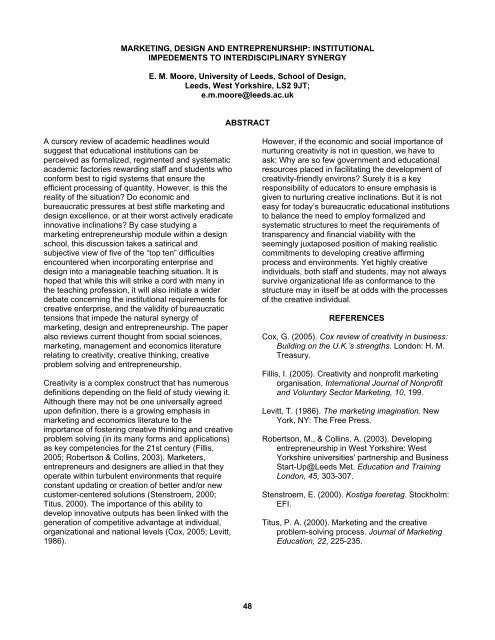2008 - Marketing Educators' Association
2008 - Marketing Educators' Association
2008 - Marketing Educators' Association
Create successful ePaper yourself
Turn your PDF publications into a flip-book with our unique Google optimized e-Paper software.
MARKETING, DESIGN AND ENTREPRENURSHIP: INSTITUTIONAL<br />
IMPEDEMENTS TO INTERDISCIPLINARY SYNERGY<br />
A cursory review of academic headlines would<br />
suggest that educational institutions can be<br />
perceived as formalized, regimented and systematic<br />
academic factories rewarding staff and students who<br />
conform best to rigid systems that ensure the<br />
efficient processing of quantity. However, is this the<br />
reality of the situation? Do economic and<br />
bureaucratic pressures at best stifle marketing and<br />
design excellence, or at their worst actively eradicate<br />
innovative inclinations? By case studying a<br />
marketing entrepreneurship module within a design<br />
school, this discussion takes a satirical and<br />
subjective view of five of the “top ten” difficulties<br />
encountered when incorporating enterprise and<br />
design into a manageable teaching situation. It is<br />
hoped that while this will strike a cord with many in<br />
the teaching profession, it will also initiate a wider<br />
debate concerning the institutional requirements for<br />
creative enterprise, and the validity of bureaucratic<br />
tensions that impede the natural synergy of<br />
marketing, design and entrepreneurship. The paper<br />
also reviews current thought from social sciences,<br />
marketing, management and economics literature<br />
relating to creativity, creative thinking, creative<br />
problem solving and entrepreneurship.<br />
Creativity is a complex construct that has numerous<br />
definitions depending on the field of study viewing it.<br />
Although there may not be one universally agreed<br />
upon definition, there is a growing emphasis in<br />
marketing and economics literature to the<br />
importance of fostering creative thinking and creative<br />
problem solving (in its many forms and applications)<br />
as key competencies for the 21st century (Fillis,<br />
2005; Robertson & Collins, 2003). Marketers,<br />
entrepreneurs and designers are allied in that they<br />
operate within turbulent environments that require<br />
constant updating or creation of better and/or new<br />
customer-centered solutions (Stenstroem, 2000;<br />
Titus, 2000). The importance of this ability to<br />
develop innovative outputs has been linked with the<br />
generation of competitive advantage at individual,<br />
organizational and national levels (Cox, 2005; Levitt,<br />
1986).<br />
E. M. Moore, University of Leeds, School of Design,<br />
Leeds, West Yorkshire, LS2 9JT;<br />
e.m.moore@leeds.ac.uk<br />
ABSTRACT<br />
48<br />
However, if the economic and social importance of<br />
nurturing creativity is not in question, we have to<br />
ask: Why are so few government and educational<br />
resources placed in facilitating the development of<br />
creativity-friendly environs? Surely it is a key<br />
responsibility of educators to ensure emphasis is<br />
given to nurturing creative inclinations. But it is not<br />
easy for today’s bureaucratic educational institutions<br />
to balance the need to employ formalized and<br />
systematic structures to meet the requirements of<br />
transparency and financial viability with the<br />
seemingly juxtaposed position of making realistic<br />
commitments to developing creative affirming<br />
process and environments. Yet highly creative<br />
individuals, both staff and students, may not always<br />
survive organizational life as conformance to the<br />
structure may in itself be at odds with the processes<br />
of the creative individual.<br />
REFERENCES<br />
Cox, G. (2005). Cox review of creativity in business:<br />
Building on the U.K.’s strengths. London: H. M.<br />
Treasury.<br />
Fillis, I. (2005). Creativity and nonprofit marketing<br />
organisation, International Journal of Nonprofit<br />
and Voluntary Sector <strong>Marketing</strong>, 10, 199.<br />
Levitt, T. (1986). The marketing imagination. New<br />
York, NY: The Free Press.<br />
Robertson, M., & Collins, A. (2003). Developing<br />
entrepreneurship in West Yorkshire: West<br />
Yorkshire universities' partnership and Business<br />
Start-Up@Leeds Met. Education and Training<br />
London, 45, 303-307.<br />
Stenstroem, E. (2000). Kostiga foeretag. Stockholm:<br />
EFI.<br />
Titus, P. A. (2000). <strong>Marketing</strong> and the creative<br />
problem-solving process. Journal of <strong>Marketing</strong><br />
Education, 22, 225-235.


